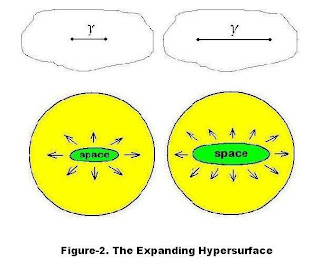The Big Bang theory
holds the premise that the universe originated from a singularity which came
into being out of nothing through a single massive explosion. The concept of
the minuscule size of such primeval singularity born from the thought
projection of the current universe's expansion backward far in time.
The theory has at least
two dubious primary grounds. The first one is the speculative concept of
nothingness. The Big Bang theory presumes, violating the first law of
thermodynamics, that energy (and matter) was created out of nothing. This idea
came from the mindset that the creation of the universe (4-spacetime) was the
beginning of everything. Notwithstanding, the theory takes for granted that the
quantum fluctuation which stimulated the primeval explosion held in the
nothingness before such creation.
The second speculative
ground is about the size of the universe which can be shrunk indefinitely
backward in time from the current size into a singularity. Close to the moment
of creation, the size exponentially shrunk about 1060 smaller
just within 104 seconds, from 10-33 to 10-37 second
posterior to the explosion, the rate of which was exceedingly faster than the
speed of light1.
As we have elucidated so
far, there can be no such thing as nothingness. The energy, as the only reality
in nature, can neither be created out of nothing nor destroyed into nothing.
The universe was born as the result of the interplay between the opposite
(positive and negative) energies that created the universe and everything
within, not out of nothing.
We can mathematically
describe energy in its pure condition as waves' spectrum of different
frequencies and amplitudes expressed in terms of Fourier series or its complex
form, the Laurent series:
f(z) = F+(z)
+ c0 + F–(z)
It is a wave function
expressed as the sum of its positive frequency (F+(z)) and
negative frequency (F–(z)).
 Globally, we can depict
this wave function in terms of Riemann sphere, the positive frequency F+(z)
extends holomorphically into the southern hemisphere, and the negative
frequency F–(z) extends holomorphically into the northern
hemisphere, where the equator represents the real coordinate and
the longitudinal circles its imaginary time coordinate.
Globally, we can depict
this wave function in terms of Riemann sphere, the positive frequency F+(z)
extends holomorphically into the southern hemisphere, and the negative
frequency F–(z) extends holomorphically into the northern
hemisphere, where the equator represents the real coordinate and
the longitudinal circles its imaginary time coordinate.
The domain of the
positive and negative frequencies, however, does not fully extend to the poles,
as the Riemann sphere has an annulus of convergence which excludes the domain
around the zero points (singularity) as well as the infinity (Figure-1).
This pure mathematical
analysis indicates that the split of the energy cannot create a stable
interface (hypersurface) from the beginning when the energy started to
split up to a certain period where it reaches the minimum size
(represented by the Riemann sphere's inner ring of convergence). The interface created in this period would
instantly dissolve into energy.
It is only after
reaching this limit that the hypersurface comes into being where it stabilized
until it reaches its maximum size (represented by the Riemann sphere's outer
ring of convergence).
The doomsday comes when
the hypersurface reaches its maximum size.
At this particular time, the hypersurface becomes extremely unstable
that makes it break down into pieces dissolving back into pure energy. We illustrate these phenomena in Figures-2
and 3A.
This cosmology scenario
avoids the need of either the concept of singularity to represent the beginning
of the creation or the big crunch at the end of the universe's life as well as
the everlasting expansion where the universe has no dead end.

This cosmology theory
also excludes the need of the concept of cosmic hyper-inflation in the early
period of the creation (Figure-3B), as the baby universe was born in an
exceedingly larger size than that of the singularity which the Big Bang theory
presumed.
The interplay between
the positive and negative energies generates quantum fields across through the
interface (hypersurface) a), located in between the two,
perpetually creates quantum sparks (fundamental particles), the building block
of the universe. As the split (hypersurface) area is enlarging with time, new
matters are created in the expanding horizon keeping the average matter density
per area almost constant.
This cosmology concept
resembles the one of the continuous creation, steady-state expanding universe
put forward by Fred Hoyle2.
Notes:
a) We use the split
area, interface, hypersurface, and space interchangeably.
References:
1. Guth, A.: "The Inflationary
Universe," Basic Books, New York, 1997
2. Gregory,
Jane: "Fred Hoyle's universe," Oxford University Press, New York, 2005


